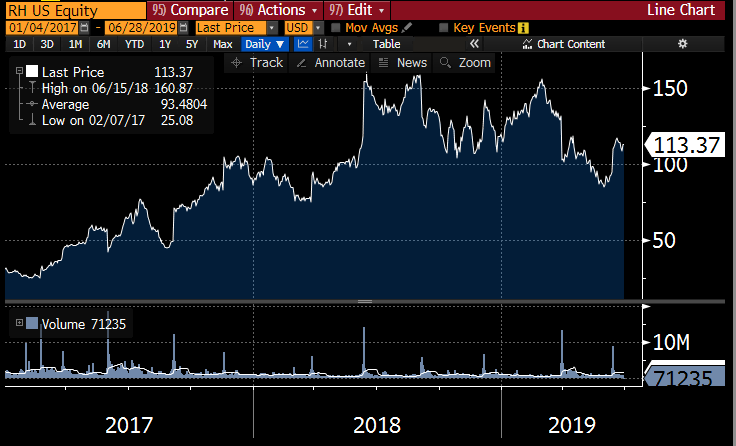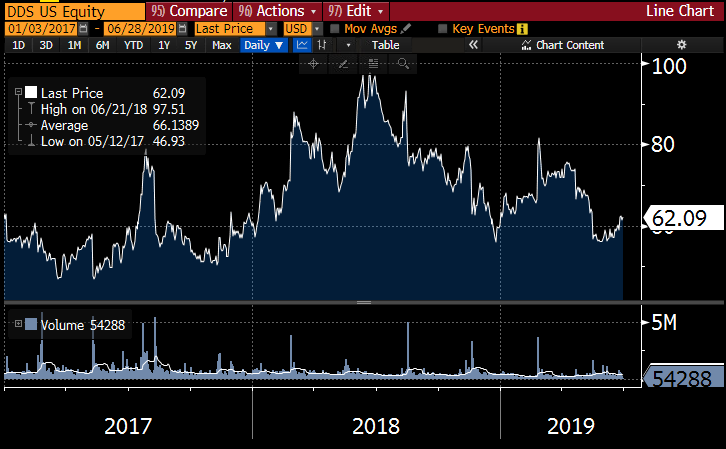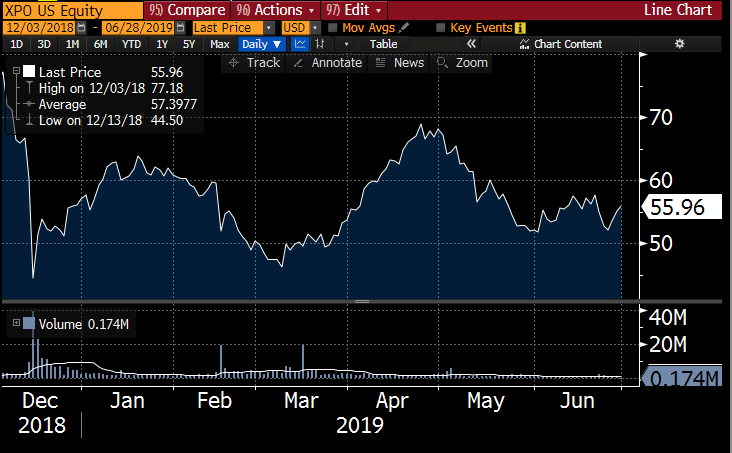You can’t fight the Fed. The share buyback parade looks like it will be accelerating further before it shows signs of moderating. So if you have been waiting for market frothiness to subside, then clearly this was not your week. And next week isn’t looking very likely either. During holiday-shortened trading weeks, we often see stocks grind higher on light trading volume.
This week the Federal Reserve approved the “capital plans” for the largest banks in the US, effectively giving these banks the green light to deploy billions of dollars toward dividend payments and share buybacks. These mega-banks did not seem the least bit surprised by the Fed’s approval. Their press releases had already been typed up and were just waiting to announce a total of more than $100 billion of share buybacks which would be conducted by Citibank (C), Bank of America (BAC), Wells Fargo (WFC), Goldman Sachs (GS) and Morgan Stanley (MS), among others.
The fact is this: no one should be surprised by these enormous share buybacks from the mega-banks. Over the last few years and across nearly all sectors, we have seen increased “tactical buying” of shares by companies or insiders, which has often caused share prices for individual companies to rise by anywhere from 50% to 500%. Or more. Last year, US companies spent a total of more than a TRILLION dollars buying back their own shares. And over the past five years, Apple (AAPL) alone has spent more than a QUARTER OF A TRILLION DOLLARS buying back its own shares.
- Banks Announce Billions in Share Buybacks After Fed Approval (US News & World Report, June 27, 2019)
- After $1 Trillion In Stock Buyback Spending, Companies Keep Their Wallets Open (Investors.com, January 12, 2019)
- Apple spends a record $23.8B buying back its own shares — and saves cash in the process (Mac June 26, 2019)
- Why Bigger Is Better for Stock Buybacks (US News & World Report, May 9, 2019)
Share buybacks are just the latest of many wide-scale market phenomenon (or tactics) that have been causing an ongoing “melt-up” in equity markets since the beginning of 2019. The triple-digit spikes in Beyond Meat (BYND) and Biopath (BPTH) are a good reminder that the “infinity squeeze” phenomenon did not end in 2018 with the 17x spike in shares of Tilray (TLRY).
- How Martin Shkreli caused a 10,000% squeeze on KBIO (Moxreports)
- Hedge funds lose $30 billion on VW infinity squeeze (Moxreports)
From a trading standpoint, it is important to recognize that not all of this “tactical buying” should be viewed equally. The differences between these situations determines a) how they might be identified in advance and b) a rough idea of how they should be expected to trade.
Below I lay out some significant differences between the “overt buying” behind Restoration Hardware (RH) and XPO Logistics (XPO) as opposed to the “covert buying” behind Revlon (REV) and Dillard’s (DDS).
(Disclosure: At various times I have been long or short a number of stocks mentioned in this report and I may later end up trading any of these long or short at any time. As of today, I am only long DDS. See my additional disclosures and disclaimers.)
Overt buying. In general, with “overt buying” like RH and XPO, companies or insiders can be seen as trying to very conspicuously drive their share prices higher. Likewise, the recent buyback announcements from the big banks are about as “overt” as it gets. In these overt situations, we typically see heavy publicity and optimistic posturing in conjunction with the announcements or purchases of shares. As a result, these trades are very easy to identify, and they will generally succeed in getting the stock prices up for some period of time. However, it is often the case that the sharpest price spikes may not be sustainable. We have seen this sort of posturing on plenty of occasions from plenty of companies.

Covert buying. Covert trades are harder to identify, but are vastly preferable from the trade standpoint. With “covert buying”, like we have seen with Revlon and Dillard’s, the companies or insiders are trying to very quietly buy more shares. As such, they benefit from lower share prices, not from higher share prices. Not surprisingly, companies in such situations often provide very little excess publicity and their public posturing might be cryptic, silent or outright bearish. This is why these trades are much harder to identify in advance. However, with the “covert trades” it is the low share price that is unsustainable. Subsequent upward moves may be sharp and sudden, or the share price may just grind up steadily for several weeks at a time. This is another phenomenon which we have seen repeatedly. However it is frequently only spotted after the fact.

The “surprise factor”. Whether they are overt or covert, the important similarity across most of these trades is the “surprise factor”. Particularly with share buybacks, the eventual reductions in share count are often only announced weeks after the shares were actually bought in the market, and even then only after most or all of the planned buying has already been completed. The decrease in share count can be significant and it is announced all at once, not spread out. This is why we often end up seeing a significant spike in the share price when the new share count numbers are later revealed in some public filing. In addition, even before the numbers are revealed, the behind-the-scenes buying from the company may have already been steadily supporting or boosting the share price for the several weeks prior to the disclosure of the amounts purchased. This is why it is important to identify these trades early in the game rather than late.
Sometimes valuation matters. Other times it does not. After completing its IPO at $17, Tilray quickly spiked to $300 before retreating to current levels around $50. But it is important to remember that whoever was paying $300 for Tilray (hopefully) didn’t actually believe that Tilray was actually “worth” $300. There are plenty of times when share prices will be driven to levels that are “too expensive” and others where they will be “too cheap”. This is another reason why (for long trades) I generally prefer to play the “covert” trades where this dynamic is working for me rather than against me.
-
Tilray (TLRY). How pricey stock borrow can predict short squeezes (Moxreports, December 2018)
“Overt” share buying at RH and XPO. Restoration Hardware (RH) was an early adopter of this “constricted float tactic”, using aggressive leveraged buybacks to send its share price up 7x from the $20s into the $160s. It is worth remembering that in 2017, RH’s CEO Gary Friedman had been granted stock options on millions of shares which would only be triggered upon the share price reaching certain trigger levels staggered at $100, $125 and $150. With the stock still sitting at around $50, such upward moves were generally deemed very unlikely. It was at just around this time that RH began announcing the approvals for a series of enormous share buybacks. The market was skeptical that CEO Friedman would actually make an attempt at such gargantuan buybacks. And even if he did, it was widely expected that doing so would crush the share price because of the necessary leverage and debt service required to execute the buyback. Instead, RH completed the first $1 billion buyback much faster than anyone had expected. And then the company announced a second buyback program for an additional $700 million. During this time, CEO Friedman was also making occasional open market purchases for his own account, while also transparently offering very bullish posturing to the market. Not surprisingly, in combination, these actions stoked the share price higher. After peaking out at around $160, RH has since retreated back to around $115 as of this week.
-
Long RH. RH Will Spike Much, Much Higher Very, Very Soon (Moxreports, November 3, 2017)
-
Furniture Boss Bets $1 Billion to Fight Skeptical Investors (WSJ, December 27, 2017)
-
RH announces $700 million share repurchase program (Marketwatch, October 11, 2018)
In December 2018, XPO Logistics copied the RH playbook almost verbatim. When XPO’s stock price was in the $40s, XPO announced that it would repurchase up to $1 billion of its shares. To the surprise of the market (including me) XPO completed this entire $1 billion repurchase in less than six weeks. And then XPO announced a second repurchase, also of $1 billion. When XPO announced its buyback. When companies lower their float, they will often see increased volatility, and this is exactly what we saw with XPO. The stock rose from the $40’s to as high as $69 and has since retreated to the $50s again. Even though I thought I had a decent understanding of XPO’s game plan, I still assumed a maximum total buyback size of perhaps $500 million at most. So even though I knew what I was looking for, I was still “surprised” at the ultimate size and effect of this buyback.

“Covert” share buying at Revlon (REV) and Dillards (DDS). When companies or their insiders are looking to buy shares, it is not surprising that we may see negative telegraphing, signaling or posturing, or else just cryptic silence. The companies or insiders then quietly buy shares “on the dips” for as long as price and volume are adequate. This is exactly what we have been seeing at Dillard’s and Revlon.
(Note: By “covert” I simply mean that such purchases are not trumpeted to the public in press releases and are not used as a signaling tool to send the share price higher along with bullish business guidance. Such purchases simply get the typical disclosure as required in SEC filings.)
The “surprise factor” behind the Dillard’s price spike. In July 2017, I published my long thesis on Dillard’s shortly after “unexpectedly” weak earnings at had caused the share price to briefly plunge into the $50s and sell side analysts downgraded the stock to targets in the $40s and below. But despite the gloom and doom sentiment, the stock steadily rebounded to the $80s and then later to the $90s. What we saw with Dillard’s was that different purchases of shares were made quietly during different weeks and were then disclosed weeks later in separate filings. The disclosure was often not overly prominent such that many investors continued to miss the share count changes even after they were disclosed in some filing. Further amplifying the “surprise factor” with Dillard’s in 2017 was the fact that disclosure of short interest data is also “lumpy”, coming out only twice per month. Note: The recent (May-June 2019) weakness in Dillard’s and the building “surprise factor” are largely a repeat of what we saw in 2017 and 2018 which sent Dillard’s as high as $98.
-
LONG DDS. Long Dillard’s on potential “infinity squeeze” (Moxreports, July 2017)
Below is an excerpt from my July 2017 report explaining the “surprise factor” which would soon take Dillard’s higher.
“Dillard’s announced Q1 (ended April) results on May 11, 2017. In that press release, Dillard’s announced that it had repurchased 1.7 million shares. This would leave Dillard’s with 26.49 million Class A shares outstanding as of April 29th.
But in the Form 10Q which was released 3 weeks later on June 6th, the share count on the cover page was only 25.178 million dated as of May 27th. This means that 1.3 million more shares were bought back in May (the first month of Q2, which will not be fully disclosed until August 10th). This 25.178 million share count number was updated on Bloomberg, but it seems that few people noticed the impact that this would have on the float, especially vs. the rising short interest.
There was NOT a press release announcing the repurchase of the additional 1.3 million shares. So during just a 3 week period, investors who had been paying attention should have realized that the float had shrunk by 3 million shares. During this same few weeks, shares short rose by 3 million shares. This is how we quietly got to a staggering short interest of 69.9% apparently without many people noticing.
The “surprise factor” with Revlon. As I explained in my recent Revlon update from last week, the easiest way to think about Revlon is to just remember “the boogeyman”. I still suspect that Revlon will ultimately get bought out in the $30s. But until then, the recurring emergence of scary-headline-boogeyman-events keeps knocking the stock down for brief intervals, during which time Ron Perelman adds to his stake. After these plunges, the share price rises 40-60% over the subsequent few weeks. And then it gets knocked back down again. And so on. Sharp drops in Revlon are in no way surprising. But given the obvious bid from Perelman under the stock, I generally see these unsurprising dips as a good excuse to get long for a few weeks or months, as long as I can get in in the mid teens. I have generally come to the conclusion that I will do better by imitating Perelman on Revlon than by trying to outsmart him.
-
Long REV. Missed disclosure changes point to Revlon buyout (Moxreports, June 7, 2018)
-
Update on Revlon long thesis (Moxreports, June 17, 2019)
Assessing the conventional wisdom about share buybacks. The conventional wisdom in academia tends to be almost invariably positive towards share buybacks. They are perceived as a win-win strategy for maximizing value to shareholders, raising the share price while still allowing the flexibility to defer gains (and taxes) until the investor feels like selling. By contrast, with cash dividends, investors must pay taxes the same year and also find a way to re-invest the proceeds. That is the conventional wisdom. But this conventional wisdom also assumes that a rational company would typically only buy back is shares when they had significant excess cash to do so and only when the share price was trading at a deep discount to the company’s other business prospects. Clearly these assumptions are not necessarily valid if a company’s “overt buying” is being motivated by financial engineering rather than by traditional corporate finance thinking. The long term sustainability of aggressive leveraged buybacks has recently been attracting scrutiny.
Stephen Gandel’s articles on Bloomberg make for good reading regarding the buybacks at RH and XPO. I also include below an article from Dividends.com, which (not surprisingly) makes the argument that dividends are a much better tool than buybacks.
-
Dividend vs. Buyback: What’s the Difference? (Investopedia)
-
Dividends vs. Share Buybacks: It’s a No Brainer (Dividend.com)
-
XPO’s Buybacks Are Too Much of a Gas Guzzler (Bloomberg, May 2019)
-
Restoration Hardware Clutters Up Its Finances (Bloomberg, Jul 2017)
When companies engage in “covert” buying, they are clearly making every effort to not overpay for their own shares. Yet even here, “covert buying” deserves some scrutiny. When companies or their insiders seem determined to buy back shares at the lowest prices possible, they often refrain from taking actions or attracting publicity which might send the share price higher right away. So instead, current and prospective investors need to figure out the (possibly promising) investment story for themselves and then wait for the price to spike later, when the market inevitably catches on by itself. This sort of opacity can be another contradiction of the academic view that buyback programs and insider buying are universally beneficial to shareholders.
But in the end, philosophy and textbooks are not what pay the bills. Understanding how these things trade has generally worked well for me. I hope you find this analysis useful.


